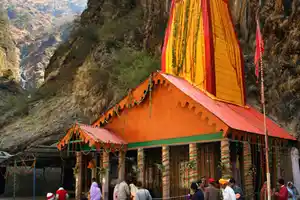History of Yamunotri
Home » Yamunotri Dham »
Temple History:
 The original source for the sacred river of Yamuna can be traced to the frozen lake of Champasar glacier which is located at a mere distance of 1 km from the main temple shrine, right on the Kalin Mountain. However, the original source cannot be accessed by trekking tails since the route is extremely narrow, treacherous and difficult to cover. In order to fulfill the requirement of the pilgrims who want to pay homage to the holy river source, Sudarshan Shah – the king of Tehri Garhwal had built a prayer spot here during the 18th century which is marked by the presence of red sacred pieces of prater flags. By 19th-century Maharani Gularia of Jaipur took it upon herself to renovate the temple which had been destroyed several times over a period of time.
The original source for the sacred river of Yamuna can be traced to the frozen lake of Champasar glacier which is located at a mere distance of 1 km from the main temple shrine, right on the Kalin Mountain. However, the original source cannot be accessed by trekking tails since the route is extremely narrow, treacherous and difficult to cover. In order to fulfill the requirement of the pilgrims who want to pay homage to the holy river source, Sudarshan Shah – the king of Tehri Garhwal had built a prayer spot here during the 18th century which is marked by the presence of red sacred pieces of prater flags. By 19th-century Maharani Gularia of Jaipur took it upon herself to renovate the temple which had been destroyed several times over a period of time.
Religious Significance of Yamunotri:
The presiding deity which is that of Goddess Yamuna holds a special place in the hearts of devout Hindus since she is considered to be an extremely powerful goddess. It is a common belief that once a devotee has offered their prayers at the deity of the idol, taken a holy dip in the sacred waters and consumed the revered Prasadam, and then only they will be able to free themselves from all their mortal sins and get a place in heaven. The river has also found its mention in the Hindu epic of Mahabharat which says that since Yamuna is one of the 7 tributaries of river Ganga, drinking its waters will absolve the sins of the pilgrim. Another popular belief is the fact that worshipping Goddess Yamuna will also please Surya god. The Prasadam which is prepared in the steaming hot waters of the thermal springs located around the main dham Shrine, is considered to be of huge importance to the devotees. It is also a significant part of the Chota char dham yatra of Uttarakhand and it is also the first stop for the Char Dham Yatra journey from where the yatra to other dhams of the circuit commences.
About Goddess Yamuna:
There are several mentions of Yamuna in the ancient Hindu texts, some of which are:
Goddess Yamuna has been mentioned as the daughter of Surya, the sun god, although there have been mention of her being the daughter of Brahma as well. She is also the goddess of clouds along with being the twin sister of Yama – the god of death. As per the Vedic traditions and literature, Yama and Yami are believed to be the first human beings on earth. Goddess Yamuna is believed to portray and exude incredible love and passion. Ancient beliefs mention the fact that whoever takes a holy dip in the waters of Yamuna will be ridden from the fear of death since the water is believed to be the liquid state of Shakti which also makes her Lord Shiva and Vishnu’s consort.
Another popular belief is the association between Yamuna and Lord Krishna. As per the ancient accounts, when Krishna’s father Vasudeva was carrying the newly born Krishna across the Yamuna river, Yamuna saw her future husband being carried through it, for the first time as a result of which, the river became extremely calm and allowed the father-son to cross it with ease. Later on, Krishna grew up and spent most of his youth life by the river of Yamuna in the holy city of Vrindavan. The Yamuna fell deeper in love with the lord seeing the love Radha and Krishna shared with each other once when the lord was playing his flute for her and the gopis.
Another interesting mention of Yamuna can be read in Bhagavata Purana when Lord Krishna had gone to Indraprastha (a town developed next to the holy river of Yamuna) to meet his cousins – Pandavas, he and Arjun decided to visit the nearby water source where he came across a beautiful lady, Kalindi (another name for Yamuna). Intrigued Krishna asked him who she was and she told him that is the daughter of the sun and is looking to marry Lord Vishnu and is performing penance in the forest nearby. Krishna (an incarnation of Lord Vishnu) agreed to marry here and he brought her back to his home.
Winter Abode:
The char dham yatra shuts down during the winter months each year due to its location on a high elevation, the region gets covered completely under snow. Also popularly known as Khushimath, this quaint hamlet is perched at an elevation of 2,675 metres above sea level. During the winter months of November to April the presiding idol of goddess Yamuna is then transferred to Kharsali where the goddess is continued to be worshipped by the regular visitors. Cradled in the lush greenery of Uttarkashi district this quiet and serene hamlet remains flocked with devotees and pilgrims during the off season.


Leave a Reply